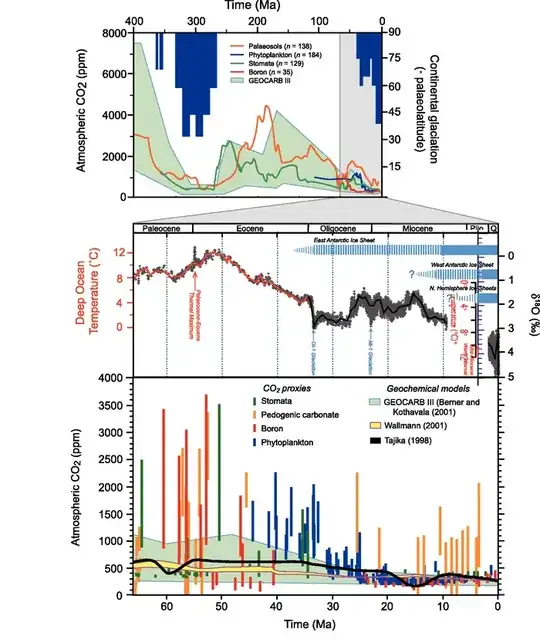Is it true that both higher and much lower temperatures existed while
CO₂ levels were ten times higher than today?
Yes. Is that surprising? No. The reason this is not surprising is that CO2 is not the only factor controlling global temperatures, and nobody claims that it is (although it is perhaps the single most dominant factor on many time scales).
However, if you look at timescales as long as 500 million years, then solar brightening becomes an important factor. It has long been known that the luminosity of stars increases with time, the "theory predicts that the solar luminosity has risen steadily from about 70% of its current value during the last 4.7 x 109yr". This leads to a what is known as the "Feint young sun paradox", first pointed out by Carl Sagan (a name that ought to be familiar) and George Mullen. The paradox being how did the Earth remain ice free for large parts of its geological history, with so little solar irradiance compared to modern times. The resolution of the paradox being that perhaps greenhouse gasses were present in the atmosphere in larger quantities at that time (although it isn't actually quite as simple as that).
That there were warmer temperatures in the past with higher levels of CO2 is easily explained, as CO2 is a greenhouse gas, that is just what you would expect. That there could have been times when it was colder with more CO2 than today is explainable by the fact that the sun is significantly brighter now than during the Ordovician (i.e. 450 million years ago), when there was a glaciation with CO2 levels higher than they are now.
Note also the radiative forcing of CO2 only rises logarithmically in its concentrations, i.e. you get a constant increase in equilibrium temperature per doubling of CO2. Thus CO2 concentrations being 10 times higher in the Ordovician does not mean that it had ten times the effect on climate than it does now. So a substantial decrease in solar luminosity, is going to need an even more substantial change in greenhouse gas concentrations to avoid a snowball Earth.
Sadly Dr Moore is raising a question, but has taken no efforts whatsoever to find out the answer. This is not very impressive given that typing "Ordovician glaciation" into Google scholar would have provided some very relevant papers on the topic, such as
Reconciling Late Ordovician (440 Ma) glaciation with very high (14X)
CO2 levels
Thomas J. Crowley Steven K. Baum
Journal of Geophysical Research: Atmospheres (1984–2012) Volume 100,
Issue D1, pages 1093–1101, 20 January 1995
Geochemical data and models suggest a positive correlation between
carbon dioxide changes and climate during the last 540 m.y. The most
dramatic exception to this correlation involves the Late Ordovician
(440 Ma) glaciation, which occurred at a time when CO2 levels may have
been much greater than present (14–16X?). Since decreased solar
luminosity at that time only partially offset increased radiative
forcing from CO2, some other factor needs to be considered to explain
the glaciation. Prior work with energy balance models (EBMs) suggested
that the unique geographic configuration of Gondwanaland at that time
may have resulted in a small area of parameter space permitting
permanent snow cover and higher CO2 levels. However, the crude snow
and sea ice parameterizations in the EBM left these conclusions open
to further scrutiny. Herein we present results from four experiments
with the GENESIS general circulation model with CO2 levels 14X greater
than present, solar luminosity reduced 4.5%, and an orbital
configuration set for minimum summer insolation receipt. We examined
the effects of different combinations of ocean heat transport and
topography on high-latitude snow cover on Gondwanaland. For the
no-elevation simulations we failed to simulate permanent summer snow
cover. However, for the slightly elevated topography cases (300–500
m), permanent summer snow cover occurs where geological data indicate
the Ordovician ice sheet was present. These results support the
hypothesis based on EBM studies. Further results indicate that
although average runoff per grid point increases substantially for the
Ordovician runs, the decreased land area results in global runoff
10–30% less than present, with largest runoff reductions for flat
topography. This response has implications for CO2-runoff/weathering
parameterizations in geochemical models. Finally, simulated tropical
sea surface temperatures (SSTs) are the same or only marginally warmer
than present. This result is consistent with evidence from other warm
time intervals indicating small changes in tropical SSTs during time
of high CO2.
That temperatures have been both higher and lower in the past and that CO2 levels were generally higher in the (geological) past. There is a good discussion of temperature and CO2 proxies at RealCLimate. Here is a noce picture of the proxy data from the IPCC AR4 (via RealClimate)

Sadly climate skeptic blogs are full of this kind of story, where someobdy has heard an apparently paradoxical combination of bits of science but not bothered to check the actual state of scientific knowledge, before rushing off to make grand claims. Google scholar however makes this fact checking relatively straightforward these days, perhaps we should ask why the likes of Moore apparently don't use it.
